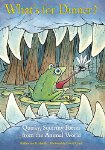For most of us humans, the process of getting our food is relatively simple. We go to a shop or a market and buy what we need. For animals, this process is more complicated. Food has to look for , which can take hours or days. If the animal eats meat, a prey animal needs to be caught and killed.
In this poetry title children will find unique poems that explore what animals eat. The sometimes 'ick' worthy poems combine humor and facts to give children an entertaining and educational experience.
 What’s for dinner:Quirky, Squirmy Poems from the Animal World
What’s for dinner:Quirky, Squirmy Poems from the Animal World
In this poetry title children will find unique poems that explore what animals eat. The sometimes 'ick' worthy poems combine humor and facts to give children an entertaining and educational experience.
 What’s for dinner:Quirky, Squirmy Poems from the Animal World
What’s for dinner:Quirky, Squirmy Poems from the Animal World
Katherine B. Hauth
Illustrated by David Clark
Poetry
For ages 6 to 8
Charlesbridge, 2011, 978-1-57091-472-0
Animals spend a lot of their time looking for food. After
all, if they don’t forage or hunt for their meals they will “croak,” and therefore
“finding food / is no joke.” Some of the things animals eat might not seem at
all palatable to us, but to them they are vital, and no doubt delicious as
well.
In this book
young readers will see how animals of different species are connected through
their need to eat. One of things that we humans forget sometimes is that all
animals are part of a food chain. Perhaps we forget because we are at the top
of our chain most of the time. In the poem Food
Chain, we see how a butterfly gets eaten by a lizard, which gets eaten by a
garter snake, which then gets eaten by a roadrunner. Every animal has a place
in a chain, and every food item that they eat has its place as well.
We may think
that animals that eat dead things are disgusting, but in fact their dining
choices serve a very useful purpose for the rest of us. The vulture for
example, who is “No dainty vegetarian,” loves carrion, and this is a good thing
too because if they didn’t disease-ridden dead bodies would be lying all over
the place.
Nighthawks and
little brown bats both love to eat insects, and they have different strategies
to catch their preferred dinners. Both animals hunt at night or in the early
evening and they catch their meals on the wing, swooping, and in the case of
the bat scooping, the insects out of the air.
Some animals
have come up with quite complicated strategies to get their food. When it is
hungry the wood turtle goes around “Stompin’ its feet / and slammin’ its
shell.” All the commotion causes worms to “pop up / to see who’s jamming,’”
which is when the turtle eats the worms.
Children who
have a fondness for things that some would consider unsavory are going to love
this book. The interesting thing is that a great deal of information is wrapped
up in these poems. For readers who would like to know more about the animals
mentioned in the book, the author provides notes at the back of the book that
are packed with more facts.
No comments:
Post a Comment